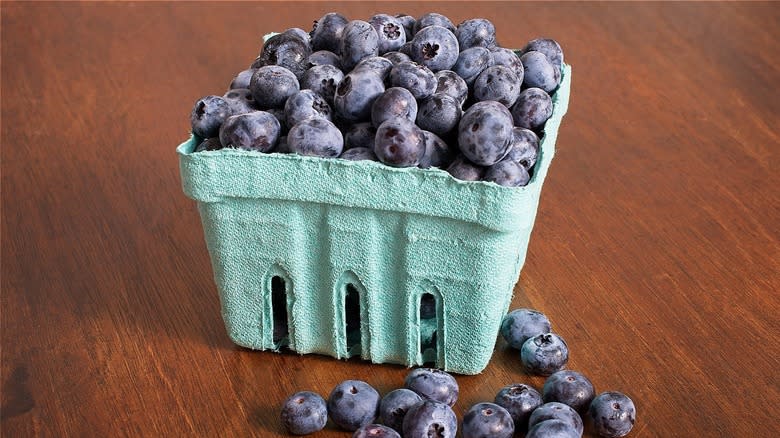The Reason A Pint Of Blueberries Weighs 12 Ounces

- Oops!Something went wrong.Please try again later.
We may receive a commission on purchases made from links.
Riddle me this: If the pint of blueberries you pick up from the grocery store weighs only 12 ounces, how much money should your grocer reimburse you, since we all know a pint is 16 ounces? Answer: Your grocer owes you zero dollars, but your elementary school teacher might want to send you an encouraging note because, while we likely passed a quiz on this matter before the fifth grade, it's still an elusive concept for the best of us.
That pint is full of gorgeous blueberries that are solid, which means they cannot be squished into every corner and crevice of the container. So, heaviness is not what the grocer means by a pint of blueberries, but rather, it's about volume. In other words, the volume of (normal size) blueberries that can fit into this size container equals a pint. It's the same idea when measuring dry ingredients for baking. This is why you are not to use your measuring cup to scoop flour from your jar, and by all means never tamp it down! You mess with the volume of flour when you do. Conversely, do tamp down brown sugar (squeeze it in real tight) because that's the volume of brown sugar that recipes mean when they call for a heaping cup.
Still confused? Consider this: It used to be even worse. Measurements lacked much standardization until 1896 when cooking icon Fannie Farmer codified them into what American chefs have been using ever since. Here's how that happened.
Read more: Fast Food Hacks That Will Save You Some Serious Money
It's Not The Metric System, So Who Standardized The American Measurements For Recipes?

According to Smithsonian Magazine, Fannie Farmer revolutionized American cooking by insisting on precise measurements in her 1896 tome, "The Boston Cooking-School Cook Book" (still in print today). Famous for establishing Miss Farmer's School of Cookery six years later, she wrote, "Correct measurements are absolutely necessary to ensure the best results" (via Amazing Women in History).
Why America refrained from joining other countries' shared measurement language of that time -- the metric system, developed by French scientists in 1799 -- still befuddles many historians. According to CNN's Margins of Error episode, "Why Americans Won't Give an Inch on Metric," Napoleon Bonaparte failed to back the metric system at its onset, even though it was meant to corral 250,000 different weights and measurements that had run amok in France. By the time Bonaparte was ousted, American engineers were ensconced in the Industrial Revolution and in need of uniform measurements. Not wishing to retool factories to accommodate France's re-emerging metric system, they opted to stick with American inches instead.
When Farmer's book published, American chefs picked up on the shared language of cups and teaspoons. Her school further solidified that meticulous approach to cooking. It graduated early chef icons, like Lena Richard, who preceded Julia Child as a television darling, Creole cookbook extraordinaire, and entrepreneur with her own line of frozen foods. It's because of Farmer's innovative spirit and firm conviction that cooking got its deserved precision.
Read the original article on Mashed.

